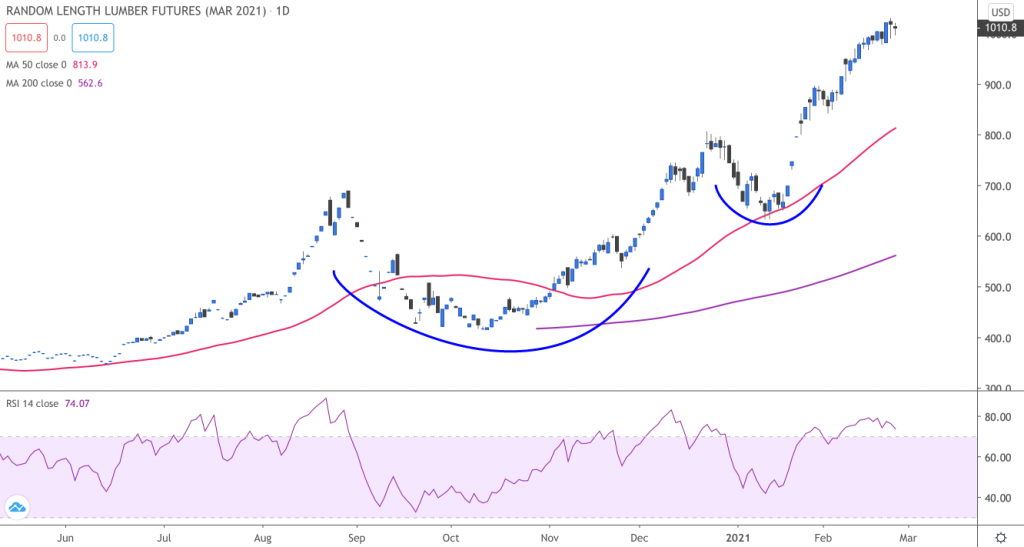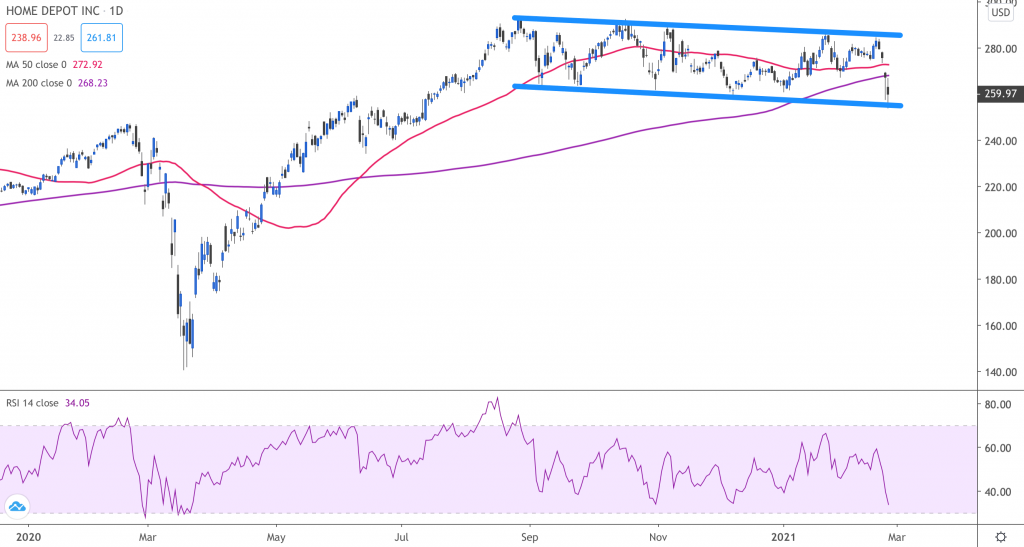These 2 stocks could get a boost as lumber prices rise and home improvement demand continues to surge.
The pandemic has sparked a boom in home builds and renovations, and that boom has pushed lumber prices ever higher.
Lumber futures surged past $1,000 for the first time last week and sit at $1,010.80 at the time of writing, up more than 130% over the last year.
“It’s the first time it’s been up in the four-digit realm, and it was somewhat expected given how intensely tight the market is and the lack of supply response,” said Kevin Mason, managing director at ERA Forest Products Research. “Inventories are lean throughout the supply chain. There is no surge in lumber production that is possible.”
And the relentless rise of lumber is showing no signs of abating any time soon.
Piper Sandler chief market technician Craig Johnson said this week that the chart for lumber is pointing to more upside ahead.
“Stay seated, but it looks like you could have 30-35% more upside, based upon the size and technical breadth of this technical setup here for lumber prices,” Johnson said. “There’s no doubt that lumber prices are going higher.”

And with the rise in lumber, Johnson says there are two familiar names that could stand to benefit: Home Depot (NYSE: HD), and Lowe’s (NYSE: L).
“If you look at Home Depot as an example, this is a stock that’s been in a downward trending price channel, and it’s very close to inflecting and reversing that channel, and starting to take another leg higher,” Johnson said. “I think that’s a stock that will probably have very good results.”

Home Depot delivered an earnings beat this week, though shares slipped lower over doubts that consumer spending on home renovations may slow this year. But the DIY-retailer posted fourth-quarter earnings per share of $2.65 on revenue of $32.26 billion. Analysts had expected a reading of earnings of $2.62 per share on revenue of $30.73 billion.
“We were pleased with our record financial performance in fiscal 2020,” said executive vice president and CFO Richard McPhail. “As we look ahead to fiscal 2021, while we are not able to predict how consumer spending with evolve, if the demand environment during the back half of fiscal 2020 were to persist through fiscal 2021, it would imply flat to slightly positive comparable sales growth and operating margin of at least 14 percent.”
Following the earnings beat, Baird analyst Peter Benedict reiterated his Outperform rating on the stock and $315 price target. Benedict said Home Depot’s fourth quarter results “capped off a record year,” and while investors are focused on the risks in a post-COVID world, the analyst said “home improvement demand will remain more durable than feared.”
And with that, “demand at Home Depot could prove more durable than the market expects,” Benedict added.
Johnson said the chart pattern for Lowe’s points to a possible breakout after the stock has formed a solid base.

Much like Home Depot, Lowe’s reported an earnings beat this week, but shares slid lower after CFO David Denton said home improvement sales may decline this year as more people get vaccinated against the coronavirus and spend more time away from home.
Still, the retailer reported that same-store sales rose 28.1% in the fourth quarter, with earnings per share of $1.33 on revenue of $20.31 billion compared to analysts’ estimates for earnings of $1.21 per share on revenue of $19.48 billion.
And while Lowe’s didn’t provide specific forecasts for 2021, the company did say that it expects “to grow market share and drive further operating margin expansion” this year.
“Home Depot and Lowe’s are going to be very good long-term holds because the work-from-home phenomenon is not going to stop with COVID,” argued Boris Schlossberg, managing director of FX strategy at BK Asset Management.
Schlossberg added that both companies could very well see margin pressure tied to the rising cost of lumber, but argued that the potential upside outweighs the risk.